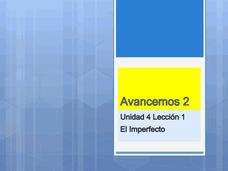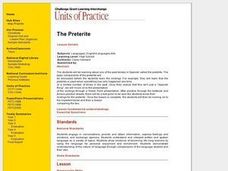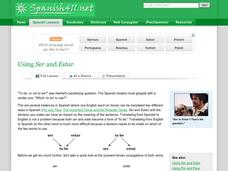Pearson
Non-Action Verbs
A verb is something you do — but can you always see the action? Use a slideshow presentation to clarify the differences between verbs that describe actions, and verbs that describe senses, preferences, and emotions.
Curated OER
El Imperfecto
You class can learn all about how to form the imperfect with -ar and -er/-ir verbs. The slides do cover the only verbs that are irregular in the tense and the situations for which you use the imperfect (plus examples). Go over the...
Curated OER
Horse Character: Ceramics Lesson
Animals oftentimes elicit various characteristics which make them symbolic or representative of human feeling, action, or emotion. The class creates horse characters out of clay to show character action and symbolism. This is a great...
Curated OER
Emotion
In this psychology worksheet, students complete 5 short answer questions on neural pathways of emotion. They explain what aspect of emotion is similar across all cultures.
Curated OER
Emotions: ACE English Program
Middle schoolers respond to prompts about emotions. In this ESL/ELL instructional activity, students develop an understanding of vocabulary and feelings associated with emotions. They identify emotions on flashcards, in magazines, and on...
Curated OER
Phrasal Verbs - Emotions
In this online interactive ESL learning exercise, students respond to 6 multiple choice questions regarding phrasal verbs. Students may check their answers with the click of the mouse.
Curated OER
ADULT ESOL LESSON PLAN--Effective Interpersonal Communication
Students explore various ways to express likes, dislikes, feelings, and emotions when communicating between people. They model these ways via pictures of food, weather, music, sports, cars, etc.
Curated OER
Strong Feelings
Students explore how emotions affect the decision-making of peacekeepers and design simulators for training emergency-response personnel.
Curated OER
Ser y Estar
Students describe the physical characteristics of animals or people, using the correct form of ser and estar. They draw pictures of people expressing different emotions and write sentences describing the emotions, using the correct form...
Curated OER
English is Confusing (Adjectives Ending in -Ed or -Ing)
In this adjectives ending in -ed or -ing instructional activity, students fill in the blanks to sentences and choose the correct verbs ending in -ing or -ed. Students complete 2 activities.
Curated OER
The Imperfect
Students practice the concept of the other past tense, the imperfect via the provided worksheet and the suggested web site.
Curated OER
ACE Expert English Homework Week 4- May 31, 2006
In this ESL activity, students complete the activities on 9 pages that pertain to emotions and adjectives that describe feelings. Included are matching, multiple choice, and short answer questions. These are geared toward ESL students...
Curated OER
The Preterite
Students practice one of the past tenses in Spanish called the preterite after the teacher presents the provided Power Point presentation.
Curated OER
What If?
Second graders read WHAT IF? up to the page that ends "Suddenly, across the field they saw..." and discuss how the animals are feeling. They then discuss their feelings and in pairs discuss a possible ending to the story.
Curated OER
Using Ser and Estar
While ser and estar both mean to be, they are each used in different situations. This is often confusing for Spanish language learners. Clarify these verbs for your class with direct instruction. The information included on this page...
Curated OER
Expressions With Break
In this expressions activity, students complete an 8 question multiple choice on-line interactive exercise about the meaning of expressions with "break".
Curated OER
PICTURE READING - PARAGRAPH WRITING
Students investigate the elements found in a media image. The image is used to compose a descriptive paragraph. They exchange papers to discuss the writing and make changes using constructive criticism. Students also make connections...
Curated OER
French: The Resistance and Occupation during World War II
Students in advanced French classes examine the French resistance during world War II. They discover what it was like living in an occupied country while increasing their vocabulary skills and applying the conditional verb tense....
Curated OER
The Preterite vs. the Imperfect
Students write their own original studenT story in the past in Spanish using the imperfect and the preterite after watching the teacher present the provided Power Point presentation on the differences in the uses of the two.
Curated OER
Poetry for Home: Homelessness
Students read a poem to learn about homelessness. In this poetry lesson, students make a list of words about their home and then feelings about their home. Students read the poem 'When I Think Home' and then write their own version of...
San José State University
Commonly Misused Words
After reviewing two pages of commonly misused words: effect/affect, accept/except, there/their/they're, etc., learners must choose the proper word in ten different sentences. Note: Answers are listed at the bottom of page three.
The New York Times
Collateral Damage? Researching a Connection Between Video Games and Violence
Hook your class into an exploration of and discussion about violence in video games with a cute animal clip and a video game trailer. After a quick discussion about how media can affect mood, class members read a related article and...
Curated OER
What is a Haiku? How Do You Write a Haiku?
Haiku poetry is explored in this language arts lesson. Yong readers identify the characteristics of haiku and read several examples. Students make connections between their study of Japan and the poetic form of haiku, and they write...
Curated OER
Yikes! An Interjection!
In this grammar worksheet, students learn about using interjections in sentence writing. They then use what they learned to answer 9 questions. The answers are on the last page.

























